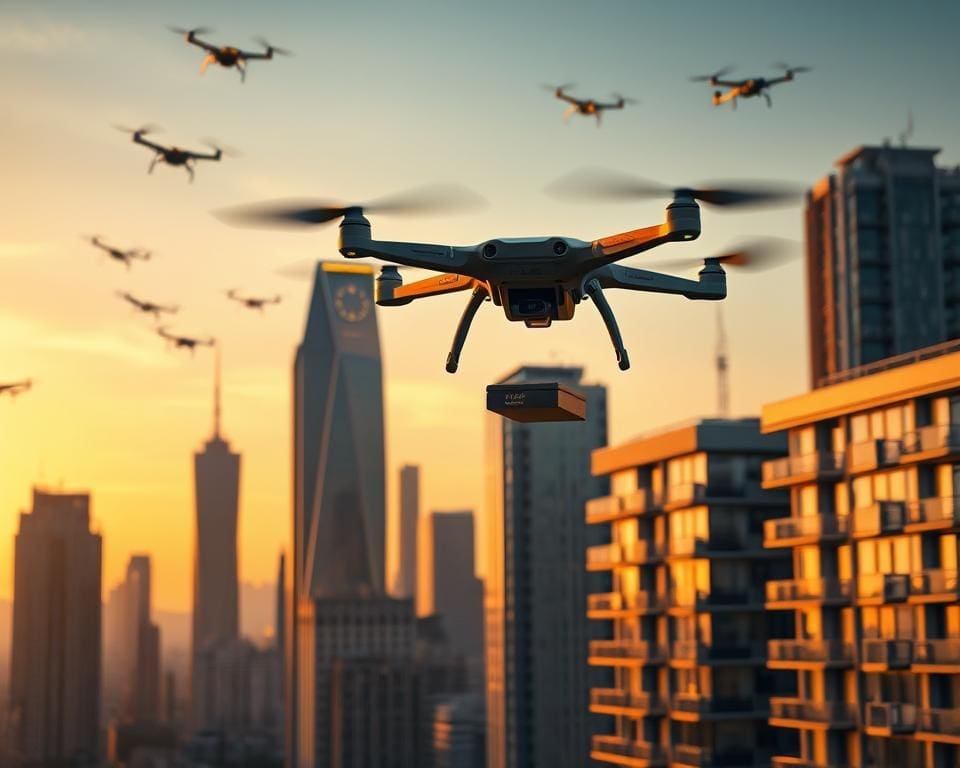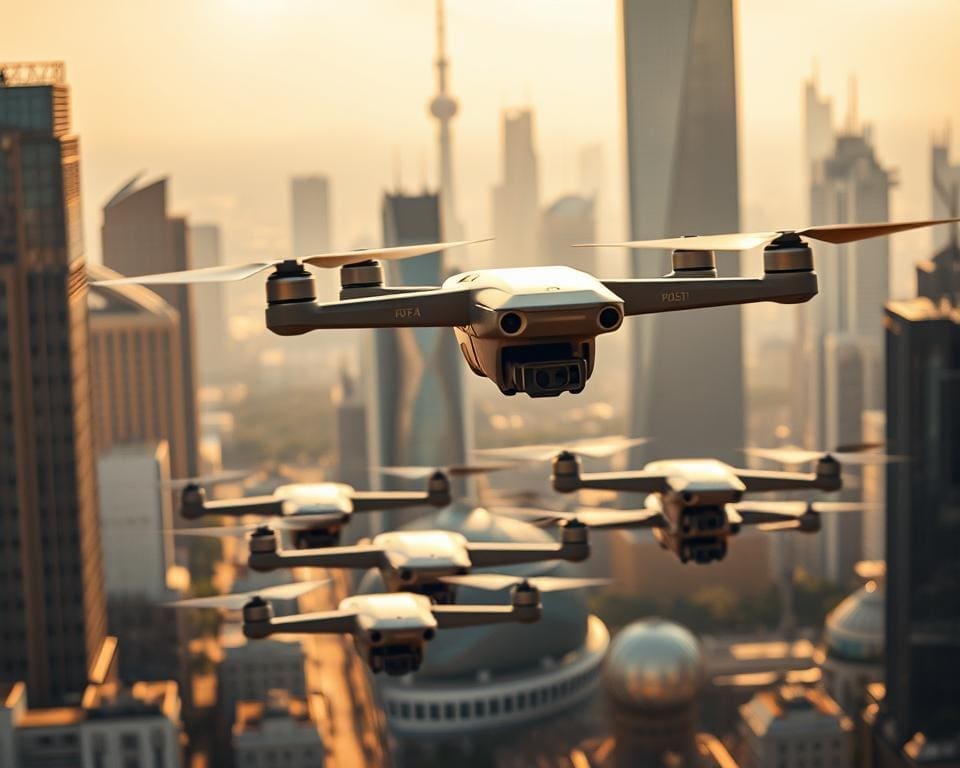The conversation surrounding the potential of drones to transform the postal service is becoming increasingly relevant as technological advancements continue to reshape our world. The postal industry has been a fundamental component of communication in the United Kingdom; however, it now faces significant challenges due to evolving delivery methods. With the rise of drone technology, questions arise about whether drones could indeed revolutionise mail services by offering enhanced efficiency, speed, and reliability.
As we dive deeper into this topic, we shall explore how drones are currently being utilised and the implications of their integration into the logistics sector. It becomes imperative to examine the feasibility of drone delivery systems and their potential impact on the postal industry, paving the way for a future where the possibility of drones replacing traditional postal services is vividly accentuated.
The Future of Drone Delivery
The landscape of delivery services is rapidly evolving, with the future of drone delivery becoming an increasingly prominent topic. As businesses embrace technological advancements in mail delivery, the integration of drones into logistics is set to transform how goods are transported. Leading companies are at the forefront of this shift, showcasing innovative solutions that promise faster and more efficient delivery methods.
Current Trends in Delivery Technology
Automation and artificial intelligence are driving forces behind current trends in delivery technology. Major players like Amazon and UPS are investing heavily in drone technology, aiming to reduce delivery times and costs. The adoption of electric vertical takeoff and landing (eVTOL) craft is particularly noteworthy, as these vehicles can navigate through urban landscapes with ease, minimising traffic delays. As a result, the drone delivery revolutionising mail services is not just a potential future, but a reality in development today.
How Drones are Being Utilised Today
In various sectors, drones have begun to play crucial roles, particularly in areas that require swift, reliable deliveries. For instance, Zipline’s innovative approach to delivering blood and medical supplies in Rwanda has demonstrated how drone technology can save lives by reaching remote locations rapidly. In urban environments, pilot programs aim to enhance package delivery efficiency, allowing consumers to receive their orders within hours rather than days. These applications are just glimpses into how the future of drone delivery can redefine speed and accessibility in mail services.

Will Drones One Day Replace the Postal Service?
The prospect of drones as a replacement for traditional postal services invites extensive consideration of both feasibility and practicality. As technological innovations continue to emerge, evaluating how well these systems can be integrated into existing frameworks becomes essential. In examining the feasibility of drone delivery systems, several key factors such as regulatory compliance, safety protocols, and current technological limitations play a significant role.
Examining the Feasibility of Drone Delivery Systems
Innovative drone technology promises speed and efficiency, yet questions linger about its implementation. The implications of drone delivery for the postal sector extend beyond mere convenience. Regulatory challenges necessitate compliance with air traffic controls and safety guidelines, creating a complex landscape for widespread adoption. Conducting successful trials in urban areas has demonstrated potential but also highlighted the need for addressing numerous logistical hurdles.
The Current Postal System vs. Drone Technology
When comparing the current postal system with emerging drone technology, one sees stark contrasts in operational capacities. Traditional postal services offer a proven track record but often suffer from inefficiencies such as delays and logistical issues. In contrast, drone delivery boasts rapid transit capabilities, appealing to a new generation of consumers. Each method presents its benefits and drawbacks, leading to a critical discussion on the evolving landscape of delivery modes. A closer look at drone vs postal service efficiency reveals the potential for drones to revolutionise the way parcels are handled and delivered, indicating a shift in consumer expectations toward speed and reliability in postal services.
Impact on the Postal Industry
The advent of drone technology holds significant promise for the postal industry. As the landscape of delivery services continually evolves, the use of drones stands to redefine how traditional mail services operate. By offering innovative solutions, these flying machines can enhance delivery speed and improve customer satisfaction, addressing many existing concerns in the field.
How Drones Could Alter Traditional Mail Services
Drones have the potential to transform traditional mail services through their ability to provide quicker delivery options. The impact on the postal industry can be far-reaching, leading to a more streamlined approach in logistics. Key benefits include:
- Speed: Drones can deliver parcels within hours, compared to the standard delivery times of conventional postal services.
- Accessibility: Remote areas can receive mail and parcels more easily, overcoming geographic barriers.
- Customer Service: Enhanced delivery tracking and real-time updates can lead to a superior customer experience.
Challenges Facing the Postal Service Today
Despite the advantages drones present, there are several challenges facing the postal service. Addressing these issues is crucial for successful adoption of postal service automation. Current difficulties include:
- Declining Mail Volumes: A noticeable reduction in traditional mail necessitates a rethink of operational models.
- Financial Constraints: Maintaining profitability while upgrading technology presents a complex dilemma for postal services.
- Need for Modernisation: Integrating new technologies requires substantial investment, which can strain resources.
Technological Advancements in Mail Delivery
Rapid progress in technological advancements in mail delivery is reshaping the landscape of logistics. Drones emerge as a vital component of this evolution, driven by innovative solutions that enhance their functionality. The ongoing improvements in the mailing process are remarkable, paving the way for an efficient future.
Innovations Leading to Drone Integration
Innovations leading to drone integration have primarily focused on several key areas, all contributing to enhancing the performance of these aerial vehicles. Significant advancements include:
- Battery technology: Improved battery life allows for longer flights and increased delivery range, making drones a more viable option for postal services.
- Navigation systems: Enhanced navigation capabilities ensure precision and safety, crucial for operating drones in residential areas.
- Payload capabilities: Greater load-bearing capacity empowers drones to carry more substantial packages, improving their usefulness in various delivery scenarios.
The Role of Artificial Intelligence in Drone Efficiency
Artificial intelligence in drone efficiency plays a critical role in optimising the entire delivery process. AI algorithms facilitate:
- Route planning: Algorithms compute the most efficient paths, reducing delivery times and fuel consumption.
- Package sorting: AI enhances sorting procedures, ensuring that parcels reach their destinations promptly and accurately.
- Drone maintenance: Predictive analytics from AI monitor drone conditions, enabling timely maintenance and reducing operational risks.
Drone vs Postal Service Efficiency
The evolution of delivery systems has brought forward various methods that compete in speed, reliability, and cost-effectiveness. Understanding the differences in efficiency between traditional postal services and the innovative use of drones is crucial in today’s fast-paced world. This analysis highlights key factors that influence the decision-making process for consumers and businesses alike.
Comparing Speed and Reliability of Delivery Methods
In the realm of comparing delivery methods, drones have shown remarkable potential to outperform traditional postal systems. Studies indicate that drones can dramatically decrease delivery times, often completing tasks in a fraction of the time taken by traditional couriers. For instance, many drone operators report average delivery times as low as 30 minutes, compared to several hours or even days for conventional services.
- Drones can bypass traffic and geographic obstacles, enabling swift deliveries.
- Real-time tracking features enhance the reliability of drone deliveries, allowing customers to monitor their packages efficiently.
- Feedback from users emphasises higher satisfaction due to timely deliveries directly at their doorsteps.
Cost-Effectiveness of Drones versus Traditional Mail
A critical aspect of the discussion on the cost-effectiveness of drones lies in operational expenses. Initial investments in drone technology can be offset by substantial long-term savings. Factors contributing to the financial argument include:
- Reduced labour costs as automation in delivery processes decreases the need for numerous personnel.
- Lower fuel expenses, as drones rely on electricity rather than conventional fuels.
- Minimised infrastructure requirements for drone operations compared to extensive postal facilities.
As businesses re-evaluate their logistics strategies, the shift towards drone technology indicates a significant transformation in drone vs postal service efficiency. The discussion surrounding this evolution is not only timely but necessary as societies adapt to new modes of delivery.
Postal Service Disruption by Drones
The advent of drone technology heralds a transformative shift in the postal industry. As companies like Wing and Amazon conduct trials, their innovations signal a recalibration of traditional delivery methods. Such postal service disruption by drones presents a unique opportunity to explore case studies of drone deployments, illustrating how these advancements can reshape logistics and consumer behaviour.
Case Studies of Successful Drone Deployments
Several key initiatives highlight the potential of drones in mail delivery. Wing, a subsidiary of Alphabet Inc., has piloted drone deliveries in various locations, passing regulatory hurdles and gaining consumer acceptance. Similarly, Amazon’s Prime Air programme showcases the company’s commitment to utilising drones for swift package delivery, promising to enhance user experience. These case studies of drone deployments reveal operational successes that position drones as a viable alternative, potentially revolutionising how parcels reach their destinations.
Impact on Jobs in the Postal Sector
The rise of drone technology raises crucial questions regarding employment within the postal sector. Concerns about workforce reductions loom large, as automation and UAVs might replace certain traditional roles. Yet, this evolution also creates new opportunities in drone management, oversight, and logistics coordination. Understanding the impact on jobs in the postal sector is essential for navigating this shift responsibly. Embracing this change could lead to a dynamic job market, rich with innovative roles tailored to an evolving industry.
Drone Delivery Revolutionising Mail Services
The advent of drone delivery technology is set to transform the landscape of mail services significantly. By harnessing the speed and efficiency of unmanned aerial vehicles, the future of postal services could witness unprecedented enhancements in delivery times and service reliability. This not only promises to satisfy the rising consumer demand for quick fulfilment but also provides a competitive edge to the entities willing to adopt this innovative approach.
As drone delivery revolutionises mail services, the implications for the postal sector are profound. Traditional models of operation may require a complete overhaul to accommodate the integration of this cutting-edge technology. While challenges lie ahead, including regulatory hurdles and the need for infrastructure adaptation, the opportunities are substantial. Embracing drones can lead to enriched services that meet modern expectations, thereby reinforcing the relevance of postal services in a digital age.
Looking forward, it is essential for stakeholders in the postal industry to recognise the seismic shifts that drone delivery heralds. Preparation and adaptability will be key as these technological advancements become entrenched in everyday operations. By proactively embracing innovations like drone delivery, the postal sector can ensure it remains a vital component of communication and logistics in a rapidly evolving world.









